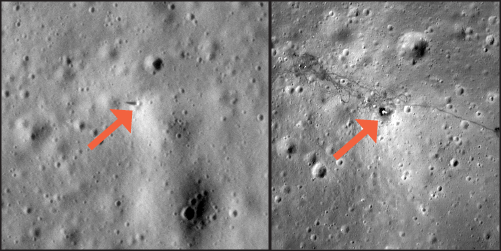
| Project Home | About the Scans | Browse Gallery | Image Map | Support Data | Resources | Ephemeris |
Featured Image - 07/08/2015
Apollo 15: Then and Now
"As I stand out here in the wonders of the unknown at Hadley, I sort of realize there's a fundamental truth to our nature. Man must explore. And this is exploration at its greatest." -Dave Scott

Figure 1. Apollo 15 Pan AS15-P-9377 of the Hadley Rille area, the
Apollo 15 landing site is in the box. North is toward the right of the frame
[NASA/JSC/Arizona State University].
Launched on 26 July 1971 at 13:34 UTC, Apollo 15 was the first of the `J-class' missions. By this time, the engineering aspect of landing humans on the Moon and returning them to Earth and been proven; now it was time for scientific exploration. J-class missions (Apollo 15, 16, and 17) had a higher capacity for exploration due to the increased water and oxygen storage in the Lunar Module (LM), and the addition of the Lunar Roving Vehicle (LRV). The extra consumables enabled the astronauts to stay on the surface for three days and the LRV allowed traverses to extend for kilometers from the LM.
Meanwhile back in orbit the Command Service Module (CSM) housed a suite of scientific instrumentation in the Scientific Instrument Module (or SIM) bay, which allowed for unprecedented orbital observations of the surface.
Each landed Apollo mission allowed for astronauts to explore the surface during Extra Vehicular Activity (or EVA). The combined total for surface EVAs for the Apollo 11, 12, and 14 missions was about 19.4 hours. As a J-mission with more advanced equipment, the total surface EVA time for Apollo 15 alone nearly matched this at 19.1 hours, while total surface EVA time for Apollo 16 (20.2 hours) and Apollo 17 (22.1 hours) individually exceeded the surface EVA time for Apollo 11, 12, and 14 combined!
The Falcon, Apollo 15's LM, landed on 30 July at 22:16 UTC. Shortly after landing, Commander Dave Scott and Lunar Module Pilot Jim Irwin performed their "stand up" EVA; after suiting up they opened the hatch in the top of the LM, and Dave Scott literally stood up and peered outside. From that eagle eye view he gave a 360° description of the local geology a nd took high-resolution telephoto pictures.
Command Module Pilot Al Worden remained in the CSM Endeavour for the duration of the mission, operating the instruments in the SIM bay and the CSM itself. Just two hours into the Falcon crew's the rest period, the Panoramic Camera in the SIM bay acquired Pan AS15-P-9377, showing the surface with lander before before Irwin and Scott stepped onto the Moon [Figure 1].
Scott and Irwin performed 3 surface EVAs with the LRV [Figure 2], collecting 77 kilograms (170 pounds) of lunar samples. Check out the details of the landing site as seen by LROC and follow the tracks left behind by Scott and Irwin: https://www.lroc.asu.edu/featured_sites/view_site/4

Figure 2.Left: the arrow shows the location of the Apollo 15 LM on the
surface of the Moon before the astronauts exited [Pan AS15-P-9377]. Right: the LM still on
the surface of the Moon several decades after the astronauts completed the Apollo 15 mission,
leaving EVA and lunar rover tracks all over the area! [NAC M175252641L/R]. North is toward
the top in both frames [NASA/JSC/GSFC/Arizona State University].
Food for thought: How much could you learn about the Earth after landing in 6 places and traversing a total of 80.9 hours (less than 3.5 days)? Find out what they were doing during their three days of lunar exploration with the transcripts here: https://history.nasa.gov/afj/ap15fj.
Tweet
|
|
Space Exploration Resources |
|
 LPI LPI
|